What Kind of Fauna Is There in Central America?
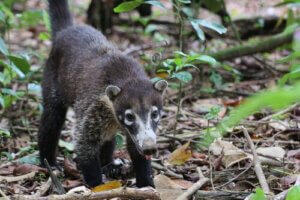
Jungles, tropical forests, high humidity… This is probably how you imagine the ecosystem of this region, where nature rules. The fauna in Central America is mainly composed of colorful birds and reptiles, although mammals and fish are also widespread. Learn about some of the most impressive species in this article.
Central American fauna
Birds with colorful feathers, large reptiles, mammals that camouflage themselves in the jungle… The fauna in Central America is really amazing. Would you like to meet some examples?
1. The white-nosed coati
Known locally as the tejón—like the one in the image at the top of the page—or pizote, this is a typical example of the fauna in Central America. Coatis live in the forests between Mexico and Ecuador, at all altitudes. They’re omnivorous—they feed on small vertebrates, fruits, eggs, carrion and insects—and diurnal. At night they always sleep in the same tree.
The white-nosed coati is known for its long tail, which is many times the length of its body, and for its white snout which ends in a point… It looks like it’s wearing a mask! Aside from this, the rest of the coat is various shades of brown and black.
2. The quetzal
This is one of the best-known birds of Central America. Famed for its beautiful colors, it’s the national animal of Guatemala, and also the name of its currency. The quetzal has a long two-colored tail, a reddish chest, and green wings and head.
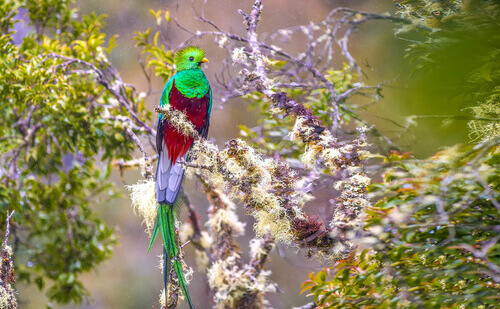
It flies very slowly, and is thus preyed on by several large birds such as eagles and owls. It feeds on fruits, insects and small frogs, although its favorite food is the avocado.
In addition, it’s monogamous during mating and breeding season, but solitary outside of it. Its eggs are blue and both parents incubate them for 18 days.
3. The eyelash viper
This venomous snake lives in both Central and South America. It’s small – no more than 30 inches long – and comes in various colors, including yellow, green and brown. Characterized by its triangular-shaped head, it also has two ‘horns’ above its eyes.
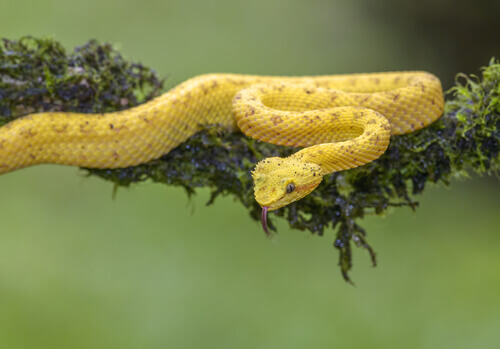
It lives in trees and dense foliage in tropical areas, near water sources. It feeds on snakes, rodents, small birds, and frogs; it’s an ambush predator and can stay in the same place without moving for hours on end, waiting for the right moment to attack its prey.
4. Dangerous Central American fauna: the poison arrowhead frog
Central America is home to many of these small and colorful, but very dangerous, arrowhead frogs. Their skin is very shiny with shades ranging from orange to blue, yellow and red, and they’re no longer than 2.5 inches.
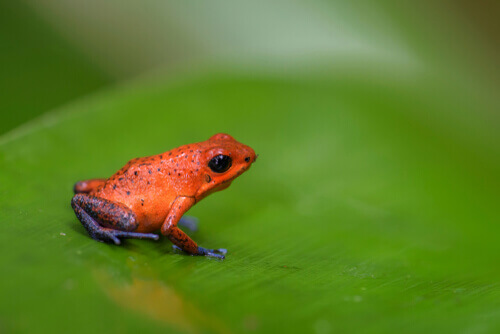
They prefer to live in cloud forests, rain forests and places with high humidity; most of them are endemic to Panama and Costa Rica. Arrowhead frogs are diurnal, feed on arthropods, and carry their tadpoles on their backs.
As for their venom, they produce it by synthesizing food – more specifically beetles – and use it to protect themselves from predators.
5. The scarlet macaw
No list of examples of Central American fauna would be complete without one of the most characteristic birds of the region. The scarlet macaw can measure up to 40 inches long and weigh up to two pounds. It lives in jungles and tropical forests near bodies of freshwater.
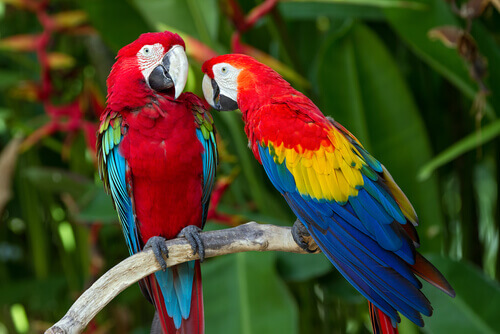
This bird is diurnal, very sociable and forms flocks of dozens of individuals; they protect each other, groom each other and give each other shelter while they sleep. Obviously, the scarlet macaw’s plumage is mostly this color, except for the wings and tail, which are yellow, turquoise and green.
Jungles, tropical forests, high humidity… This is probably how you imagine the ecosystem of this region, where nature rules. The fauna in Central America is mainly composed of colorful birds and reptiles, although mammals and fish are also widespread. Learn about some of the most impressive species in this article.
Central American fauna
Birds with colorful feathers, large reptiles, mammals that camouflage themselves in the jungle… The fauna in Central America is really amazing. Would you like to meet some examples?
1. The white-nosed coati
Known locally as the tejón—like the one in the image at the top of the page—or pizote, this is a typical example of the fauna in Central America. Coatis live in the forests between Mexico and Ecuador, at all altitudes. They’re omnivorous—they feed on small vertebrates, fruits, eggs, carrion and insects—and diurnal. At night they always sleep in the same tree.
The white-nosed coati is known for its long tail, which is many times the length of its body, and for its white snout which ends in a point… It looks like it’s wearing a mask! Aside from this, the rest of the coat is various shades of brown and black.
2. The quetzal
This is one of the best-known birds of Central America. Famed for its beautiful colors, it’s the national animal of Guatemala, and also the name of its currency. The quetzal has a long two-colored tail, a reddish chest, and green wings and head.

It flies very slowly, and is thus preyed on by several large birds such as eagles and owls. It feeds on fruits, insects and small frogs, although its favorite food is the avocado.
In addition, it’s monogamous during mating and breeding season, but solitary outside of it. Its eggs are blue and both parents incubate them for 18 days.
3. The eyelash viper
This venomous snake lives in both Central and South America. It’s small – no more than 30 inches long – and comes in various colors, including yellow, green and brown. Characterized by its triangular-shaped head, it also has two ‘horns’ above its eyes.

It lives in trees and dense foliage in tropical areas, near water sources. It feeds on snakes, rodents, small birds, and frogs; it’s an ambush predator and can stay in the same place without moving for hours on end, waiting for the right moment to attack its prey.
4. Dangerous Central American fauna: the poison arrowhead frog
Central America is home to many of these small and colorful, but very dangerous, arrowhead frogs. Their skin is very shiny with shades ranging from orange to blue, yellow and red, and they’re no longer than 2.5 inches.

They prefer to live in cloud forests, rain forests and places with high humidity; most of them are endemic to Panama and Costa Rica. Arrowhead frogs are diurnal, feed on arthropods, and carry their tadpoles on their backs.
As for their venom, they produce it by synthesizing food – more specifically beetles – and use it to protect themselves from predators.
5. The scarlet macaw
No list of examples of Central American fauna would be complete without one of the most characteristic birds of the region. The scarlet macaw can measure up to 40 inches long and weigh up to two pounds. It lives in jungles and tropical forests near bodies of freshwater.

This bird is diurnal, very sociable and forms flocks of dozens of individuals; they protect each other, groom each other and give each other shelter while they sleep. Obviously, the scarlet macaw’s plumage is mostly this color, except for the wings and tail, which are yellow, turquoise and green.
This text is provided for informational purposes only and does not replace consultation with a professional. If in doubt, consult your specialist.








